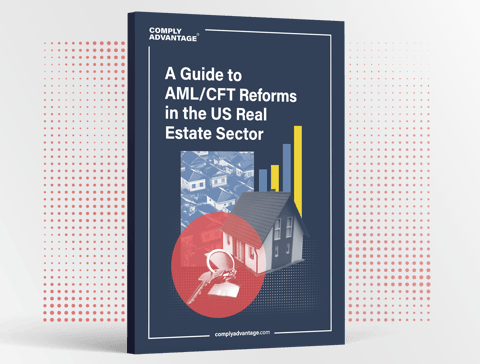In 2023, the US real estate sector was valued at $113.6 trillion. However, the sector has faced many challenges due to inflation, high interest rates, and the rise of remote work, leading to vacant commercial properties. Additionally, authorities have expressed concerns about the increasing levels of illicit finance in high-end residential purchases.
Our Guide to AML Reforms in the US Real Estate Sector considers the state of the industry in-depth, exploring common risks, regulatory trends, and best practices for compliance staff.
Financial Crime Risks in Real Estate
The Financial Action Task Force (FATF) and US regulators stress that the starting point for all firms is understanding the financial crime risks facing their business and responding appropriately. Financial crime risks that real estate businesses need to be aware of include:
- Money laundering: Criminals often use property purchases to integrate illicit funds into the legitimate financial system, allowing them to invest funds in a large asset that can appreciate over time and generate legitimate income through rent, renovation, and future onward sale. The US has some regulatory barriers to prevent this abuse, but real estate remains vulnerable due to the significant role that shell companies are allowed to play in property purchases. These non-publicly traded companies have a limited physical presence and undertake little economic activity, hiding ownership and control through nominee directors and intermediary shareholders.
- Sanctions risks: Money laundering and sanctions evasion are often linked, with many individuals and organizations seeking to launder illicit funds also being liable to be designated under US sanctions. The US has a wide range of sanctions against transnational criminals, terrorists, corrupt officials and business people, and human rights abusers. The overlap between money laundering and sanctions has become more evident since the Russian invasion of Ukraine in 2022, with many oligarchs linked to President Putin being designated under US sanctions. Sanctioned Russian elites and their proxies have been trying to hide funds in US real estate, especially the commercial sector, which has raised concerns by the Financial Crimes Enforcement Network (FinCEN).
- Fraud: There are multiple types of real estate fraud, but most involve a combination of impersonation and the use of false information. Common typologies in the sector include:
- Mortgage fraud, which involves falsifying information to obtain a mortgage.
- Title fraud, where individuals impersonate real homeowners to sell a property and keep the proceeds without the owner’s knowledge.
- Real estate investment trust (REIT) fraud, when criminals falsely represent themselves as representatives of REITs to seek investments in non-existent properties.
- Business email compromise (BEC) fraud, where communications are manipulated to divert expected payments to the criminal’s account.
AML Reforms in the US Real Estate Sector
The anti-money laundering and combatting the financing of terrorism (AML/CFT) regulatory framework for real estate businesses is set globally by the FATF’s 40 Recommendations, which cover financial institutions that provide loan finance to buy properties and the professionals that support the execution of the transaction.
FATF’s Preventive Measures for Real Estate Firms
The FATF's Risk-Based Approach Guidance for the Real Estate Sector suggests that real estate professionals should follow preventive measures similar to other obligated entities. The guidance promotes a risk-based approach, where measures are applied sensitively, depending on the business and its operating context. Real estate firms must undertake customer due diligence (CDD), identify politically exposed persons (PEPs), and report suspicious transactions to the financial intelligence unit (FIU) as a suspicious activity report (SAR). Firms must also implement AML/CFT programs appropriate to the business’s size, nature, and risk profile. Key elements include appointing a senior compliance officer, staff training, and an independent audit function.
FATF’s Recommendation on Beneficial Ownership
Alongside these preventative measures, the FATF’s Recommendation 24 sets out requirements for BO data. Since March 2022, governments are recommended by the FATF to establish and maintain accurate and updated national beneficial ownership registries. These registries are primarily intended for use by regulators, law enforcement agencies, and other public bodies. However, the FATF suggests governments should also consider providing access to obligated entities to help them undertake necessary preventive measures. In March 2024, following the implementation of the Corporate Transparency Act, the US was upgraded to “largely compliant” with Recommendation 24.
Current US AML Regulations on CDD and Beneficial Ownership
The primary legislation governing AML/CFT in the US is encompassed in the Bank Secrecy Act (BSA), the PATRIOT Act, and the AML Act 2020, which are enforced by Final Rules issued by FinCEN. Under this legal framework, certain CDD requirements apply for real estate professionals, including:
- CDD is not necessary for cash transactions.
- CDD is only required for financial institutions providing credit.
- Residential mortgage loan originators (RMLOs) only need to conduct CDD on the buyer's side.
- Non-obligated real estate firms must report transactions exceeding $10,000, report foreign bank and financial account holdings annually, and record/report international currency movements.
In relation to beneficial ownership regulations, there is currently no federal requirement for businesses to maintain beneficial ownership (BO) information or a federal BO registry, however, this is about to change. The collection of company information, including BO, is defined by state laws. The US currently has a federal BO requirement in real estate called the Geographic Targeting Order (GTO), which requires title insurance companies to report the BOs behind shell companies buying properties over $300,000 in designated areas. The most recent GTO was issued in April 2023.
The Corporate Transparency Act (CTA)
US legislators have pushed for changes that will improve corporate transparency, which are intended to make it harder for criminals to use shell companies to buy real estate. The National Defense Authorization Act 2021 (NDAA), passed in January 2021, incorporated the AML Act of 2020 and the Corporate Transparency Act (CTA) of 2019, which required FinCEN to create a BO registry that would oblige over 32 million businesses to file details of their BO with the US government. The legislators behind the Act stated their explicit intent not only to meet FATF demands but to better enable law enforcement, fight financial crime, tackle overseas corruption, and improve US economic security. The Biden administration strongly supported the changes, viewing them as an important part of its strategies for Countering Corruption and Combating Terrorist and Other Illicit Financing.
The changes required under the CTA came into force on January 1, 2024, but new and existing entities have different reporting deadlines. Companies that are already established have to file an initial return by January 1, 2025. Companies formed after January 1 had only 30 days to file. These changes will directly affect the reporting responsibilities of real estate firms but, more widely, will accelerate the growth of transparency in the sector. Current US policy attempts to reduce the volume of dirty money in real estate, and the federal government is looking for real estate professionals to help.
Further Proposed Changes - Non-Financial Transactions
In February 2024, FinCEN issued a proposed rule that would “require certain persons involved in real estate closings and settlements to submit reports and keep records on identified non-financed transfers of residential real property to specified legal entities and trusts on a nationwide basis.” The rule focuses on “non-financed” - i.e., all-cash - deals. Currently, FinCEN states that these transactions avoid both AML and SAR filing scrutiny. While real estate closing and settlement professionals would remain exempt from BSA AML requirements, it would require “businesses, including attorneys, performing specified closing or settlement functions for the non-financed sale or transfer of residential real property to an entity or trust, to collect and report information to FinCEN.” This includes BO information for the legal entity, information about individuals representing the transferee entity, information about the property being sold, and information about payments being made.
FinCEN proposes a “modified SAR” - known as a Real Estate Report - that would be filed for any sale or transfer that meets the requirements outlined in the rule. This would help ensure the reporting person does not need to maintain a wider AML program. The regulator plans to consult on the form this will take later in 2024.
AML Compliance Checklist for Real Estate Companies
By identifying and addressing potential risks, real estate firms can reduce their exposure to financial crime and minimize their exposure to legal penalties and regulatory scrutiny. But what steps can compliance teams take to ensure their AML systems are both effective and efficient?
1. Understand the Wider Risk Environment
Money laundering and terrorist financing are constantly evolving threats that require businesses to go beyond simply ticking boxes on a pre-determined checklist of potential issues. Instead, real estate firms of all types should ensure they understand the risk environment in which they operate. Three criteria for firms to consider include:
- Customer risks
- Geographic risks
- Product/service/channel risks
2. Implement Effective Controls
After performing a risk assessment, companies must decide on the necessary anti-financial crime framework. This includes appointing a senior compliance officer, creating governance structures, policies, and procedures. However, given the current focus of the US government on identifying beneficial ownership and enhancing CDD standards, companies should prioritize the following areas:
- Identity verification
- Know your customer (KYC) measures
- Screening
- Ongoing monitoring
3. Strategically Leverage Technology
Technology can help streamline CDD processes by automating risk assessments and compliance. Implementing machine learning, cloud computing, and application programming interfaces (APIs) can assist in identifying high-risk behavior patterns, manage large volumes of customer data, and access specialized tools for risk assessment and screening. It's crucial to choose reliable technology partners for high-quality risk data and adaptable platforms.
4. Calendarize Regulatory Milestones and Deadlines
It is crucial for real estate businesses in the US to stay informed about the latest regulatory changes and important dates. One key date to keep in mind is the filing deadline for BO information, which runs from January 1, 2024, to January 1, 2025. In addition, it's important to monitor updates from FinCEN regarding final rules on access, changes to CDD, and real estate reporting and recordkeeping.
Advanced AML Solutions for Real Estate Professionals
Property companies must have strong AML compliance policies and professionals working in the sector should receive regular, up-to-date training about emerging threats and regulatory requirements. When it comes to technology, investing in the right tools is vital to effectively detect financial crime red flags and efficiently remediate alerts. Real estate firms looking to enhance their AML systems, should prioritize solutions that offer the following advanced capabilities:
- Custom rule creation: Ensure transaction monitoring and fraud detection systems provides detailed explanations for flagged alerts. This aids in understanding potential risks and supports informed decision-making.
- Explanatory AI alerts: Look for systems that allow easy customization of rules to address specific real estate money laundering patterns. This adaptability ensures relevance to evolving threats.
- Behavioral analysis: Seek systems with advanced behavioral analysis capabilities. This uncovers anomalies and patterns, providing insights into sophisticated money laundering activities within real estate transactions.
- Network analysis: Consider solutions employing network analysis to examine relationships between entities involved in real estate transactions. This comprehensive view reveals intricate connections, enriching the understanding of potential money laundering networks.
- Predictive analytics: Explore systems with predictive analytics models. These assess the likelihood of real estate transactions being linked to money laundering, enabling proactive risk management and preventive measures.
For more information on how firms can navigate AML reforms in the US real estate sector, download the guide below.
 Request a Demo →
Request a Demo →
 The Compliance Team’s Guide to Customer Onboarding - Part 1
The Compliance Team’s Guide to Customer Onboarding - Part 1
 The State of Financial Crime 2023
The State of Financial Crime 2023
 ComplyAdvantage Takes on Payment Fraud with New AI-powered Solution
ComplyAdvantage Takes on Payment Fraud with New AI-powered Solution
